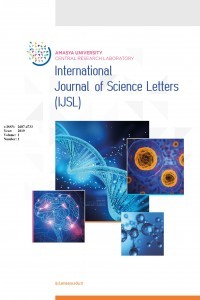Physicochemical properties of both drinking and domestic waters in Çorum
Physicochemical properties of both drinking and domestic waters in Çorum
___
- Aazami, J., Esmaili-Sari, A., Abdoli, A., Sohrabi H., Van den Brink, P. 2015. Monitoring and assessment of water health quality in the Tajan River, Iran using physicochemical, fish and macroinvertebrates indices, Journal of Environmental Health Science & Engineering, 13:29.
- Begon, M., Townsend, C.R., Harper, J.L. 2009. Ecology: from individuals to ecosystems, London, UK: Blackwell Publishing.
- Cieszynska M., Wesolowski, M., Bartoszewicz, M., Michalska, M., Nowacki, J. 2012. The application of physicochemical data for water-quality assessment of watercourses in the Gdansk Municipality (South Baltic coast). Environmental Monitoring and Assessment, 184(4), 2017-29.
- Çelekli, A., Öztürk, B. 2014. Determination of ecological status and ecological preferences of phytoplankton using the multivariate approach in a Mediterranean reservoir. Hydrobiologia, 740,115–135.
- Engman, E.T., Gurney, R.J. 1991. Remote sensing in hydrology; Chapman and Hall Ltd. London, UK.
- Gholizadeh, M.H., Melesse, A.M., Reddi, L. 2016. A comprehensive review of water quality parameters estimation using remote sensing techniques, Sensors, 16 (1298).
- Gu, Q., Deng, Ke Wang, J., Lin, Y., Li, J., Gan, M., Ma, L., Hong, Y. 2014. Identification and assessment of potential water quality impact factors for drinking-water reservoirs, International Journal of Environmental Research and Public Health, 11, 6069-6084.
- Ogren, S.A. 2014. Using indicators of biotic integrity for assessment of stream condition, Michigan Tech. 7(5):10–9.
- Samsunlu, A. 2013. Environmental engineering chemistry, Birsen Publications, İstanbul, pp398.
- TS 266, Water intended for human consumption, Instıtute of Turkısh Standards, Ankara. 2005.
- Usali, N., Ismail, M.H. 2010. Use of remote sensing and gis in monitoring water quality, Journal of Sustainable Development, 3, 228–238.
- Water for People Water for Life 2003 The United Nations world water development report. http://unesdoc.unesco.org/images/0012/001295/129556e.pdf.
- Yayın Aralığı: Yılda 2 Sayı
- Başlangıç: 2019
- Yayıncı: Amasya Üniversitesi
Microbiological properties of both drinking and domestic waters in Çorum
Seda MESCİ, Zübeyir TUNCEL, Rüveyda TURBAY
The effect of ATP-binding cassette (ABC) transporters in human cancers
Seda MESCİ, Sevgi MARAKLİ, Burak YAZGAN, Tuba YILDIRIM
Transposons Continue the Amaze
Retrotransposon Analyses in Cucurbitaceae family
Photophysical Chracterization of Galanthus elwesii Hook
Ebru BATİ AY, Melek GÜL, Beril KOCAMAN, Muhammed Akif AÇIKGÖZ
Tuba YILDIRIM, Farid SADATİ, Berna KOCAMAN, Belgin SİRİKEN
Physicochemical properties of both drinking and domestic waters in Çorum
